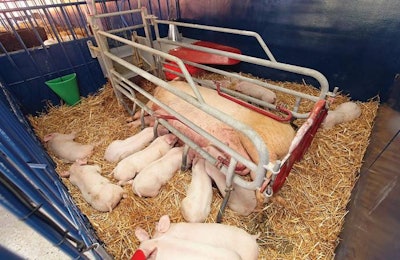
“Days 60 to 70 of gestation are a critical time point for fetal and mammary gland growth,” said Dr. Sung Woo Kim, professor of nutrition at North Carolina State University, during the webinar Feeding hyperprolific sows for profitable piglets hosted by WATT Global Media. With producers working to increase litter numbers since the 1970s through the use of genetics and other variables, it is important to understand the nutritional needs of pregnant sows both pre- and post-farrowing. “We have, on average, 3.3 more pigs per litter than we did 45 years ago,” said Kim.
Not only are the number of hogs per litter growing, but also so are the fetal sizes per hog, making it more important for the sow to offer proper nutrients. “As of 2004, fetuses were 40 percent bigger than they had been in the past.” Kim explained. When looking at statistics pertaining to a sow’s ability to supply milk to these growing numbers, Kim found that in 1935 sows were only producing 3 kilograms of milk per day compared to almost 12 kilograms per day in 2010. “Sows today are highly prolific and producing more than sows in the past; they’re very different animals,” Kim said.
Feeding sows
Kim spent time analyzing quantitative changes in the fetus and mammary glands during gestation and how that is related to the growth of baby pigs after farrowing. The protein gained in each fetus was very low until day 70. “There was only 2.5 grams of protein in each fetus per day until day 70 but there was an increase in late gestation, each fetus had 4.6 grams of protein in each fetus each day,” said Kim. This makes the sows need to have enough protein very important to the fetus.
There is also a big difference in the need for lysine in different parts of the gestation period, as well as other amino acids.
The importance of proper feeding is even more important during late gestation. “Sows need increased nutritional supports from day 60 of gestation including amino acids, antioxidants, vitamins and minerals,” Kim said.
Gestation
In early gestation Kim found that most fetuses were very comparable in size; however, at days 60 to 70 he found at least one fetus significantly smaller than its litter mates. Once that piglet was behind in terms of size it would stay that way through the later parts of gestation and birth. “This means sows do not supply enough nutrients to supply all the fetuses,” said Kim.
A fetus located in the core of the uterus tends to be smaller than the fetus located to the outside of the uterus, he explained.
Mammary gland
Mammary gland growth happens mainly during late gestation. “Sows use more nutrients at this time to support the growth of mammary glands,” Kim said. Not all mammary glands grow to the same size. The third, fourth and fifth mammary glands in the middle of the sow are the biggest. “This is important because the mammary gland size is related to the amount of milk production and that is related to the growth of suckling babies,” Kim noted.
Kim discussed results from a study that showed piglets sucking the first five pairs of mammary glands had a better average daily gain than piglets sucking the back mammary glands.
“In early gestation, the amount of protein accreted in a mammary gland was very low at only .14 grams per day, until day 80 the accretion of protein increased by more than 24 times,” Kim said. This means there is a big difference in the need for protein per sow from early to late gestation in order to promote the growth of the mammary gland, he explained.
Protein accretion in mammary gland systems mostly occurs during late gestation with all amino acids multiplying by at least twenty times.
Role of trace minerals — epigenetics concept
Epigenetics is a way to turn external modifications to the DNA on and off without making any changes to the DNA sequences, explained Dr. Mercedes Vazquez-Anon, senior director of animal nutrition research and facilities for Novus International. This is really a manipulation of the genes, she added.
This method has helped with evolving sows as litters continue to grow. “We know as we increase the litter size there is a reduction in birth weight,” Vazquez-Anon said. The reduction in birth weight or variation in sizes comes from an increase in differences for the piglets through gestation as Kim discussed. “It’s part of the price we pay for highly prolific sows,” said Vazquez-Anon.
Vazquez-Anon has focused on how to take full advantage of nutrition to maximize piglet growth not only in the gestation process but also post farrowing as well. “By understanding epigenetics, we can overcome some of the challenges that the sow has,” Vazquez-Anon said.
Trace minerals have been used in experimental studies to help not only the sows but also the piglets through their entire lifecycle. “What you feed to the sow can have a long-lasting effect on the piglet, even up to improvements in carcass quality,” Vazquez-Anon said. Through a feeding experiment Vazquez-Anon found that the sow fed trace minerals had progeny that were heavier, farrowed larger litters, there was a reduction in mortality, and at market they were heavier at their 160-day weight.
“Trace minerals are important for sows’ reproduction and performance and to impact progeny performance,” said Vazquez-Anon.

















